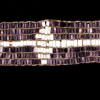Relatives/Heritage items
Displaying 1881 - 1900 of 4694 Relatives
Browsing allows you to see all the records for relatives and heritage items in the GKS. You can also search by material made, and/or filter by nations. To search by material made, type the material's name, by example 'leather', in the box below and click “Apply.” You can select multiple nations from the dropdown list by pressing “Ctrl” (on PC) or “Command” (on Mac) and clicking, then select “Apply.”
A pipe tomahawk-head carved of soapstone; from the "Cherokesen" Cherokee?; obatined from Mr. Köhler in 1846.
L-shaped pipe bowl carved of soapstone; of the "Cherokesen" Cherokee?; obtained from Dr. Engelmann in 1840.
L-shaped, profiled pipe bowl carved of soapstone with old lead repair; of Sioux (prob. Dakota) origin; obtained from Dr. Engelmann in 1840.
A realistic, three-dimensional sexual scence carved on top of a L-shaped steatite pipe bowl; obtained from the "Tscheroke" Cherokee by Mr. Köhler and donated to the museum in 1840.
A wooden Midwiwin drum stick shaped like a bird's head with cotton wrapped grip. This Midwiwin drum stick was collected by William Jones for the American Museum of Natural History, N.Y. in 1904-05.
Iron tomahawk pipe with wooden handle.
Tomahawk pipe. Northeastern North-American, made before 1882. Collected by William Bragge and purchased by the British Museum from W. Wareham in 1882.
A bandolier bag with floral bead work; obtained from John Perrot, an Anishinaabe/French-Canadian, in Couchiching, near Fort Frances, Ontario; purchased from William Jones
A brief history of three Chippewa families and their removal from surrendered lands on the Anderdon Reserve. See IT242 - Copy of Surrender.
A wampum belt with triangle and double calumet motifs. Of Huron (Wendat) origin. Probably relating to a treaty between the Huron (Wendat) Confederacy and the Tobacco (Tionontate) Nation in 1637. One of four wampum belts collected by Horatio Hale and purchased from him by Professor
A loom woven wampum belt from the Huron (Wendat) Confederacy. It likely relates to a treaty between the Huron Confederacy and the Tobacco (Tionontate) Nation in 1637. One of four wampum belts collected by Horatio Hale from Chief Joseph White while at the Anderdon Reserve
Covering letter accompanying three certified copies of deeds from Boulton to Jarvis concerning surrendered lands in Alnwick Township. See IT221 - Memorial of 17 May 1842, IT222 - Memorial of 3 August 1843, IT223 - Memorial of 12 July 1843.
The Delaware Nation of Indians residing on the Moravian Reserve do surrender unto the Crown a tract of land adjoining the River Thames. The land will be sold for their benefit and several conditions shall be met. See IT210 - Original or Duplicate Surrender, IT211
The Delaware Nation of Indians residing on the Moravian Reserve do surrender unto the Crown a tract of land adjoining the River Thames. The land will be sold for their benefit and several conditions shall be met. See IT210 - Original or Duplicate Surrender, IT211
Acceptance of a recommendation to approve the surrender of the Moravian Reserve in Orford and Zone by the Delaware Nation of Indians. Several conditions related to the surrender were accepted as well. See IT210 - Original or Duplicate Surrender, IT211 - Original or Duplicate Surrender
The relative is a model of an Odawa birchbark jiiman, canoe, with six wooden figures, carved by Jean-Baptiste Assiginack. The jiimaan with six carved figures is thought to be a symbolic record of Odawa war chiefs who fought alongside the British in the War of 1812
The Delaware Nation of Indians residing on the Moravian Reserve surrendered unto the Crown a tract of land adjoining the River Thames. The land will be sold for their benefit and several conditions shall be met. See IT210 - Original or Duplicate Surrender, IT212 -
A bone roach spreader with attached eagle feather and silk ribbon. Obtained by William Jones from a Mesquakie man near Tama, Iowa.
 Knowledge Sharing Platform
Knowledge Sharing Platform















